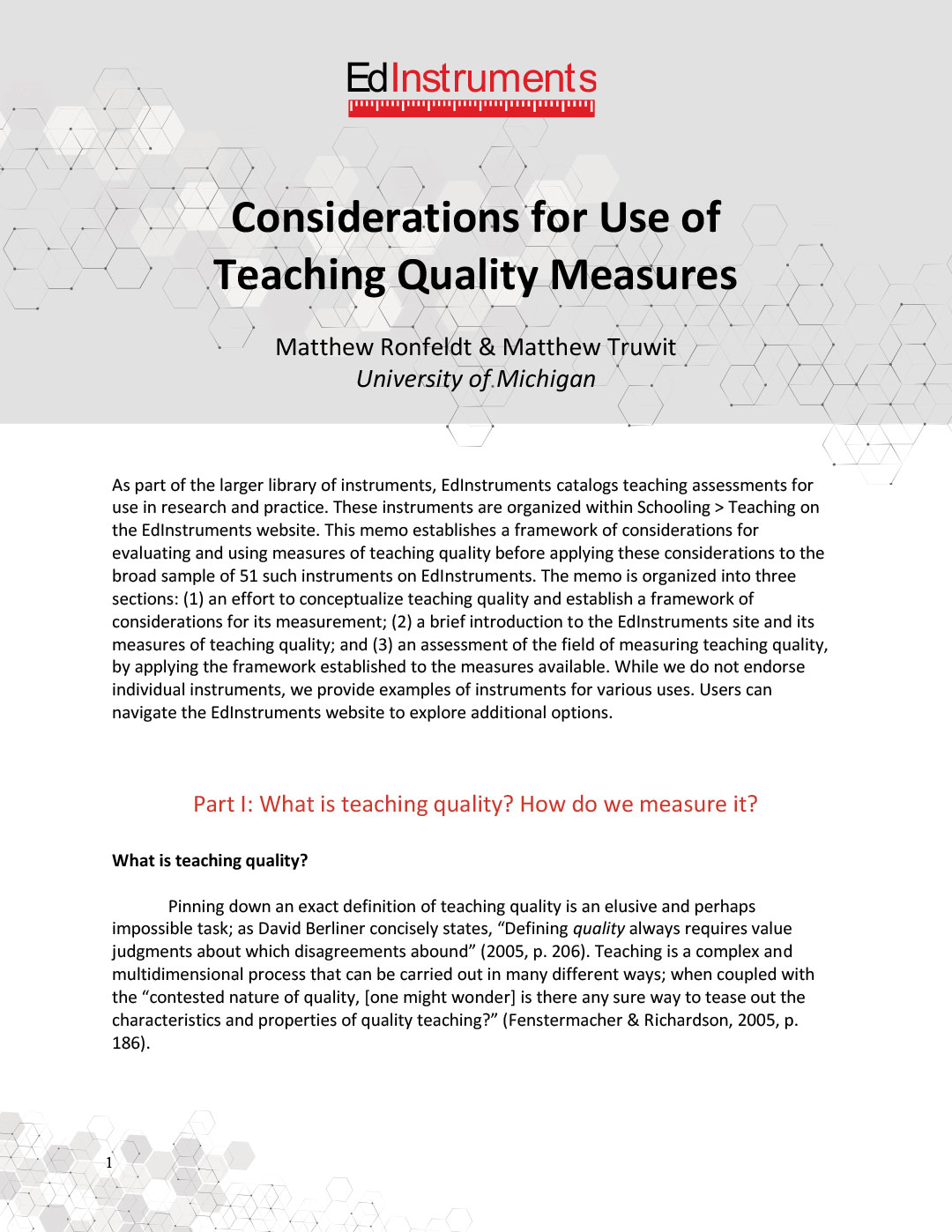Matthew Ronfeldt & Matthew Truwit
University of Michigan
As part of the larger library of instruments, EdInstruments catalogs teaching assessments for use in research and practice. These instruments are organized within Schooling > Teaching on the EdInstruments website. This memo establishes a framework of considerations for evaluating and using measures of teaching quality before applying these considerations to the broad sample of 51 such instruments on EdInstruments. The memo is organized into three sections: (1) an effort to conceptualize teaching quality and establish a framework of considerations for its measurement; (2) a brief introduction to the EdInstruments site and its measures of teaching quality; and (3) an assessment of the field of measuring teaching quality, by applying the framework established to the measures available. While we do not endorse individual instruments, we provide examples of instruments for various uses. Users can navigate the EdInstruments website to explore additional options.
What is teaching quality?
Pinning down an exact definition of teaching quality is an elusive and perhaps impossible task; as David Berliner concisely states, “Defining quality always requires value judgments about which disagreements abound” (2005, p. 206). Teaching is a complex and multidimensional process that can be carried out in many different ways; when coupled with the “contested nature of quality, [one might wonder] is there any sure way to tease out the characteristics and properties of quality teaching?” (Fenstermacher & Richardson, 2005, p. 186).
Despite the philosophical challenges inherent in defining teaching quality, many educational researchers have dedicated their careers to the task. These efforts have only served to reinforce the breadth of what teaching quality can encompass. For example, based on reviews of classroom observation systems, Bell et al. (2019) identify a vast number of dimensions of teaching quality, including a safe and stimulating classroom climate, productive classroom management, high levels of student involvement and motivation, clear explanation of subject matter, rich, precise, and accurate representations of subject matter, deep cognitive activation, cyclical assessment for learning, highly differentiated instruction, and the explicit modeling and scaffolding of learning and self-regulation strategies for students. Meanwhile, Goe et al. (2008) comb research literature, policy documents, reports, and more to construct a five-point definition of effective teachers, who “have high expectations for all students …, contribute to positive academic, attitudinal, and social outcomes for students …, use diverse resources to plan and structure engaging learning opportunities; monitor student progress formatively, adapting instruction as needed; and evaluate learning using multiple sources of evidence …, contribute to the development of classrooms and schools that value diversity and civic-mindedness, … [and] collaborate with other[s] … to ensure student success, particularly the success of students with special needs and those at high risk for failure” (p. 8). Darling-Hammond (2021) studies the standards for practice in five different high-achieving countries to consider how definitions of teaching quality vary around the world, finding common conceptualization as a wide-ranging knowledge base of not only content and pedagogy (or the learning process) but also the diverse social, emotional, and academic needs of students in order to effectively respond to their individual trajectories for learning; moreover, she notes that “the framework for defining teaching quality has expanded and defines an increasingly evidence- and inquiry-based conception of practice …, as well as one that is increasingly child-centered and focused on concerns for equity and multiculturalism” (p. 296).
In short, although there is near universal agreement that teaching quality matters, there is far from universal agreement as to what exactly it entails. The clearest conclusion is that teaching quality is multifaceted, contextually dependent, and connected to student learning. However, even this last point is not without a difference of opinion. While many have adopted a parsimonious operationalization of teaching quality that is narrowly based on the learning of students, this empirical turn has been met with a wide range of legitimate critiques (Goe et al., 2008). Fenstermacher and Richardson (2005) cleverly resolve this tension by providing a helpful distillation of quality teaching into two related concepts—good teaching and successful teaching. Good teaching entails meeting thresholds of adequacy in the task sense, performing the logical, psychological, and moral acts of teaching in a way that “comports with morally defensible and rationally sound principles of instructional practice. Successful teaching is [that which] yields the intended learning” (p. 189). In their conceptualization, one can enact good teaching without yielding intended learning (i.e., successful teaching); likewise, successful teaching need not be good (e.g., effectively teaching a child how to pickpocket). Quality teaching occurs only when both conditions are met.
We do not bring these examples to bear with the goal of settling on a conclusive definition of teaching quality. Instead, we illuminate the field’s diversity of opinions in order to underscore the importance of considering one’s own perspective as to what teaching quality means before embarking on its measurement. A clear conceptualization of teaching quality—or an explicit bounding of teaching quality to a well-defined dimension—is the first step in deciding how to measure it. Ultimately, we agree with Gitomer and Bell (2013), who state, “Although reasonable people disagree about what distinguishes high-quality teaching, it is important to identify clearly the constructs that comprise teaching quality and how those constructs may be understood relative to the measures used” (p. 8).
